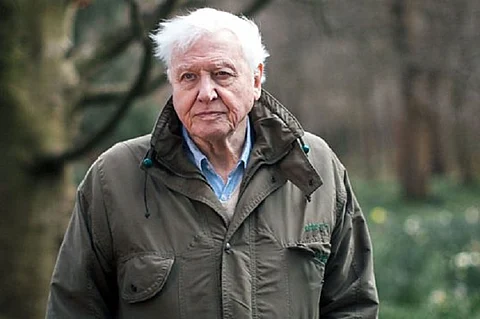

Two people are walking in the snow, shovelling it away till they hit the hard ice underneath. Beneath the surface of the ice, we see several white bubbles – round and opaque. One of them hits on the ice where a bubble can be seen. A hissing sound, and gas visibly gushes out from the bubble. A lit stick is brought into the picture, and before you know it, the small flame catches on to the gas rushing out of the ice, and becomes a cloud of fire, rising up into the air with an ominous whoosh.
While watching BBC Earth’s Climate Change: The Facts, this scene stood out the most for me, for it seemed to perfectly encapsulate what will happen if we don’t do something to contain, reduce and reverse the damage we’ve done to the planet. The bubbles under the arctic ice that the duo burst here are filled with methane, a greenhouse gas much more potent than carbon dioxide – this becomes amply clear as it fuels the cloud of fire gushing out of the ice. This is what we risk releasing into the air as the arctic ice caps melt.
Climate Change: The Facts, directed by Serena Davies, is narrated by David Attenborough, a natural historian whose voice is familiar for his soothing commentary on several documentaries on wildlife and biodiversity. In the last two decades, however, he has lent his voice for the issue of climate change and global warming. And in this documentary, Attenborough, along with several other scientists and experts, presents facts and calls for action.
The film has lots of what you would expect in a climate change documentary – shots of ice caps melting and falling, floods, wildfires, gloriously tall trees being brutally hacked down. However, what it successfully manages to do is link the micro to the macro.
Climate change can seem like such a humongous concept, too far off to be affected by one person’s solitary actions. Or, so it appears on the micro level – a choked river, plastic-cleaning drives, one person or community making their lifestyle sustainable. Climate Change: The Facts makes you question the smallest actions such as buying chocolate or biscuits that is leading to deforestation (since these products require palm oil), and most products like packaged food and makeup that we use on a daily basis.
Another example is how the film deals with the topic of fossil fuels, which we know by now is a major culprit in global warming. The documentary shifts the focus away from just vehicles and industries for just a moment, and brings the attention just how we consume them even when we don’t realise it. As Naomi Oreskes, a science historian and professor at Harvard University puts it in the documentary, “The problem is that everything we do, our entire economy, from the moment you wake up in the morning to turn on the light, or look at your cell phone to the moment you go to bed at night, and even then because your cell phone is drawing power at night… We are all using energy all the time. In the industrialised world, that energy is almost entirely [from] fossil fuels.”
In taking this approach, the film makes painfully clear how just a rise of one degree – which doesn’t seem like a lot for a whole planet – starts with just one act. And the effects are devastating.
That being said, the film does not advocate that we turn into hermits, relinquish our technological solutions and conveniences, or give up hope. The latter part of the film is about realistic solutions and how they are achievable, despite the massive scale of devastation already caused. And here is where Climate Change: The Facts is also a call to action to each individual. And here is where we see Greta Thunberg, the 17-year-old who has taken the world by storm with her movement for climate justice.
Referring to her Fridays for Future protests, where Greta started skipping school every Friday to protest, she says, “Why should we go to school if we don’t have a future? What’s the point of learning facts when the most important ones don’t matter?” It is moving to see how Greta and other kids are earnestly demanding that they and children of the future do not suffer for the mistakes and recklessness of adults before them. And it’s a demand we can, and must no longer ignore.
Climate Change: The Facts is a wholesome package – it serves as a primer for someone who has little knowledge about the what or the why of climate change; and it also has nuance and depth. However, I did wish it focused more about the non-western world, because those are the peoples that are most vulnerable to climate change, most likely to be displaced and affected by the likes of floods, storms and fires. There are some mentions like the Kerala floods and those in Bangladesh, and how developing and underdeveloped countries will pay the heaviest price for a phenomenon that developed countries have most aggravated. However, there could have been some more attention and depth there.
In all, Climate Change: The Facts showcases a focused and non-alarmist approach to climate change (unlike, say, An Inconvenient Truth). It doesn’t need to do anything else, because the alarm bells inevitably start sounding once you are presented with the facts.
Climate Change: The Facts will premiere in India on March 7 (Saturday) at 9 pm on Sony BBC Earth.
Disclaimer: This review was not paid for or commissioned by anyone associated with the series/film. TNM Editorial is independent of any business relationship the organisation may have with producers or any other members of its cast or crew.